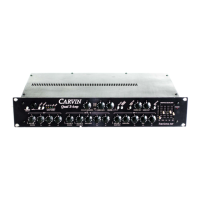when overdriven was simply an accident. This meant that the only way to get distortion effects
was to play at a very loud volume. Soon technicians discovered that they could add a master
volume control between the preamp and the power amp stages of guitar amps in order to provide
a volume control for the distortion effects. This let players turn up the preamp volume to get
overdrive and then turn down the master volume control to set the overall loudness. Soon
manufacturers added master volume controls to their amps, but the basic tube circuitry remained
unchanged.
6.2 The Tube Cascade™
At the outset of the Quad X-Amp project we knew we wanted to do something new with tubes.
We surveyed every significant tube guitar amp ever made and came to a surprising conclusion.
They were all basically the same. Yes, they had their minor differences in features and
packaging but by and large everybody had just copied the early Fender circuits. Most
importantly, there was little new design work being performed on the actual overdrive sound.
The overdrive sound of most amps was not much more than an accident. We were not content to
simply place another Fender clone in pretty packaging along with some extra features.
We searched for the essence of the tube sound. Our earlier work had disproved the old truism
that says "tubes produce even order harmonics and transistors produce odd order harmonics".
That is a grossly simplistic view of the complex waveforms that can be produced by any
overdriven circuit. The mathematical method of Fourier analysis readily predicts the harmonic
structure of any waveform based on the shape of the wave. Using the method of Fourier
analysis it can be shown that tubes can be used to produce either odd or even harmonics or
combinations of the two, just as solid state circuits can. There is more to the tube overdrive
phenomenon than that often repeated claim of odds versus evens.
The Dance of the Harmonics!
Besides the ear, our primary tool for studying overdrive effects was a computer based spectrum
analyzer. As we studied the tube overdrive spectrum closely we realized that we were seeing not
only a mix of odd and even harmonics, but that the amplitudes of each of these two families of
harmonics were alternately rising and falling with the attack and decay of each note. In addition,
as each harmonic family would rise and fall a series of notches would sweep up and down
through that family of harmonics. Not only was the harmonic structure rich in content but there
was a lot of activity among the harmonics. In comparison, the harmonics from solid state
circuits would just rise and decay with each note. These simple circuits had none of the
harmonic agility of the tube circuits. There can be no doubt that this "harmonic dance" accounts
for most of the audible differences between otherwise similar tube and solid state circuits.
Using the methods of Fourier analysis we then related the harmonic activity of the tube circuits
to the modulation of the waveform that resulted from the coupling of at least two tube stages.
Typical amps always used at least two coupled stages. It seemed that if the sound of 2 or 3
coupled stages was good, maybe a system with more complex coupling could produce a more
complex harmonic dance and sound even more rich. More coupling means more tube stages.
We tried seven tube stages and saw a more complex modulation and heard more depth. Nine
Quad X-Amp About Tubes Section 6
6-2

